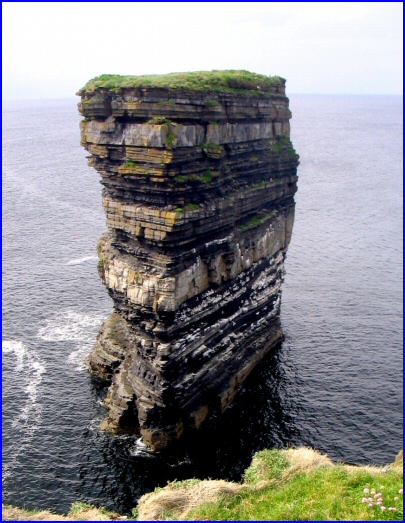|
From Castlebar - County Mayo - Mayo Historical and Archaeological Society Dun Briste, a Sea-stack off Downpatrick Head, Co. Mayo. Dun Briste, an impressive sea-stack, estimated to be approximately 50 metres in height, stands 80 metres off Downpatrick Head, in the town-land of Knockaun, east of Ballycastle, Co. Mayo. The cliffs in the area, including the stack, were formed in the Lower Carboniferous period, a geological term applied to a time c. 350 million years ago, when the sea temperatures around Ireland were much higher than today. On the adjoining Downpatrick headland, several archaeological monuments may be seen, and these range in type from Bronze-Age ring-barrows, early ecclesiastical sites, the remains of a promontory fort, to a more modern coastguard ’watch-house’ of W.W.2 vintage. Each year, Downpatrick is frequented by birdwatchers who come to observe and record the many different species which take up positions on the stratified face of the stack as the seasons change. In May and early June, the headland itself is a blaze of colour when the sea-pink comes into bloom. Poll na Seantoine, a cavernous blow-hole, which has been hollowed out by the unrelenting wave action of the Atlantic Ocean, is an awe-inspiring sight, its sheer walls reaching nearly 30 metres down to the churning waters. Some years ago a small monument was erected as a memorial to several men who are reputed to have died there, after the 1798 uprising. They had taken refuge in the cavern to avoid the Redcoats who were pursuing them, but were trapped by the incoming tide and all drowned. There are several stories in folklore as to how the sea-stack came to be cut off from the mainland. One tells of Geodruisge, an ogre, who lived on the spot where the stack now stands. He was a most unpleasant character, often making life difficult for St. Patrick, who prayed frequently at the church on Downpatrick Head. The saint became exasperated, and prayed to God to ‘put some barrier of separation between this tyrant and himself.’ The following morning the stack with the tyrant’s residence was found to be separated from the mainland. Geodruisg had no means of escaping and so he perished. - A good story, but hardly true, and there are other variations on the same theme, where Geodruisge did not fare out quite so badly. A passage in the annals by MacFirbis is a more likely explanation, it tells of the cutting off, of the rock of Duross promontory by the sea, in the Barony of Tirawley, in 1393. Local lore tells that the people living there were rescued from the stack with the use of ship’s ropes. Some years ago, a helicopter landed several people on the stack; they were the first humans to set foot there for centuries. The party included Dr. Seamus Caulfield and his late father Padraig Caulfield, NT.; Fr. Declan Caulfield, R.I.P.; Noel Dunne, archaeologist; and Prof. Martin Downes, formerly of Castlebar. They camped there overnight and surveyed the surface where they found the remains of a medieval house, cultivation ridges, walls, and a broken quern stone (a stone used for grinding corn). A camera crew recorded the event and a documentary was broadcast on R.T.E. television some time later. The cliff-scenery at Downpatrick Head is majestic; on a clear day the coastline of counties Sligo and Donegal are visible, but extreme care is necessary when nearing the cliff edge. Do not approach on a windy day, and children especially, should be carefully supervised at all times.
© Copyright 2007 by Castlebar - County Mayo - |
